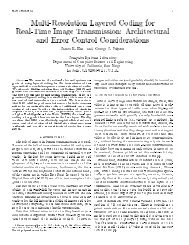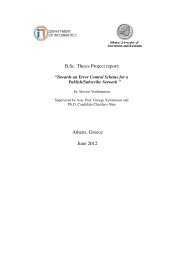In Network Processing and Data Aggregation in
In Network Processing and Data Aggregation in
In Network Processing and Data Aggregation in
Create successful ePaper yourself
Turn your PDF publications into a flip-book with our unique Google optimized e-Paper software.
Benefits1. It is a completely distributed <strong>and</strong> localized solution for the periodic aggregationproblem <strong>and</strong> is not error prone to node failures (unlike the solutions that make use ofaggregation-trees) due to the broadcast nature of the communications that are performedbetween the nodes.2. Simulations showed that it achieves significant energy sav<strong>in</strong>gs for some thresholdparameters (Th).DrawbacksIt needs the exchange of big volumes of <strong>in</strong>formation between the nodes when thecomput<strong>in</strong>g aggregate is more complex than the cases of MAX/MIN (e.g. MEDIAN,HISTOGRAM etc.).Gossip-Based Computation of aggregates [9]<strong>In</strong> this paper [9], a new theoretical method is proposed for the computation ofaggregates (like sums, averages, r<strong>and</strong>om samples) with gossip-style protocols. But whyshould someone use a gossip based protocol? Here are some characteristics of them thatare enough to conv<strong>in</strong>ce someone about the benefits from us<strong>in</strong>g them:a) It is known that gossip-based algorithms perform well <strong>in</strong> terms of scalability.b) Each node communicates with one or a few nodes of its neighborhood, thus, onlylocal <strong>in</strong>formation is neededc) Simplicity of design <strong>and</strong> operation. Usually, gossip-style protocols do not requireerror recovery mechanisms, while often <strong>in</strong>curr<strong>in</strong>g only moderate overhead, compared tooptimal determ<strong>in</strong>istic protocols such as the construction of data dissem<strong>in</strong>ation treesd) They achieve high stability under stress <strong>and</strong> disruptions. <strong>In</strong> comparison,traditional techniques have absolute guarantees, but are unstable or fail to make progressdur<strong>in</strong>g periods of even modest disruption.It is po<strong>in</strong>ted out that the po<strong>in</strong>t-to-po<strong>in</strong>t Uniform Gossip protocol is not suitable forwireless sensor networks. <strong>In</strong>stead, an alternative distributed broadcast-based algorithm isproposed, namely flood<strong>in</strong>g. The convergence of the flood<strong>in</strong>g algorithm is analyzed by








